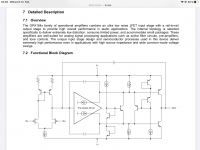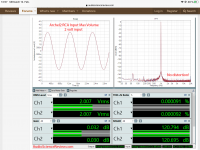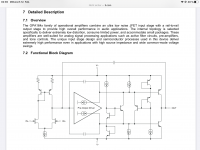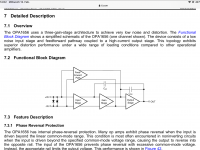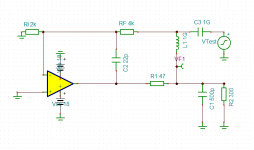... consider that the distortion of the output amplifier is reduced by the loop gain of the input amplifier. Because the loop gain of the input amplifier is finite, any increase in the distortion of the output amplifier will still appear at the composite's output.
This is one reason why Wayne Colburn's WHAMMY composite amplifier makes a lot of sense. Its second stage (output) amplifier runs pure class-A at 67mA / 100mA (builder's choice) bias, controlled by an optoisolator bias servo. The output transistors are power devices mounted on hefty heatsinks. Thus: very low distortion.
The Rojo composite HPA I demonstrated at Burning Amp 2019, did a very similar thing: high bias, heavily heatsinked, pure class-A second amp, but with a lot more open loop gain and no optoisolator.
One reason the Groner/Polak combo does so well (-200dB @ 1kHz) is because they let the output amp run open loop, with an overall fb loop from output to driving opamp input. That means that the output signal of the driving opamp, which determines the distortion, is just millivolts, making its distortion extremely low.
Jan
Jan
This is one reason why Wayne Colburn's WHAMMY composite amplifier makes a lot of sense. Its second stage (output) amplifier runs pure class-A at 67mA / 100mA (builder's choice) bias, controlled by an optoisolator bias servo. The output transistors are power devices mounted on hefty heatsinks. Thus: very low distortion.
The Rojo composite HPA I demonstrated at Burning Amp 2019, did a very similar thing: high bias, heavily heatsinked, pure class-A second amp, but with a lot more open loop gain and no optoisolator.
This WHAMMY headphone amplifier was also designed with ST’s BDW93/94 darlington pair as mentioned by Wayne COLBURN. Do you know how to install them instead of the MosFets ? Any components value change or schematics for this specific darlington output stage inside the WHAMMY ?
This is one reason why Wayne Colburn's WHAMMY composite amplifier makes a lot of sense. Its second stage (output) amplifier runs pure class-A at 67mA / 100mA (builder's choice) bias, controlled by an optoisolator bias servo. The output transistors are power devices mounted on hefty heatsinks. Thus: very low distortion.
The Rojo composite HPA I demonstrated at Burning Amp 2019, did a very similar thing: high bias, heavily heatsinked, pure class-A second amp, but with a lot more open loop gain and no optoisolator.
Not very low at all. It THD+N is even worse then a simple opa1688 alone
On the DAC side, there's less audio development. Paul Frost from the DAC team in Tucson is active on here. I highly recommend you harass him about creating new audio products. Sometimes it helps if its not always coming from me
Hi everyone, John is correct that there is less audio development on the DAC side. There are new DACs (technically) in the TAS digital input class D devices (TAS3251, for example).
On the bright side, our precision DAC team has released our new flagship 20-bit R2R DAC, the DAC11001A. I am excited to see if anyone wants to try to use it for audio
I am working on an audio reference design using the DAC11001A that I hope to release on the web in the next few months. It is a bit of a science project, but I am seeing nice audio performance and I am using John's opa1656 as the primary output buffer.
I can create a new thread on that when I release the design guide.
Not very low at all. It THD+N is even worse then a simple opa1688 alone
Well, you can't expect much more from the good old opa604. Composite amps can get better results due to the available feedback of the output opamp, especially if using modern opamps. But sticking an opa1642 in there could already improve things, if it is stable on that PCB.
I can create a new thread on that when I release the design guide.
Please do!!
//
Well, you can't expect much more from the good old opa604. Composite amps can get better results due to the available feedback of the output opamp, especially if using modern opamps. But sticking an opa1642 in there could already improve things, if it is stable on that PCB.
I don't think it's the case, opa604 has more feedback at 1khz than opa1642.
I dunno.. maybe I'm putting my foot in my mouth again and it's a bit difficult to say as we don't know at which level those measurements were made. Still, they seem to hit the thd levels of the opa604 itself, which hints at the opa604 being the limiting factor. The opa1642 has indeed less open loop gain but its intrinsic thd is quite a bit lower. It might be a wash in the end though.
Some (Belcher in his papers from the 1970s, for example) argue that -80 dB THD is audible for some. That's why some of us use -100 dB to be on the safe side. You can argue that going below that is a waste of time/effort, but then again, I think precision does sell, and being able to design a precision circuit says something about the skill of the circuit designer. I'd like to think there's a good correlation between good measurements and a high quality product. I know there is one between good measurements and a positive listening experience (Olive, Toole).
Tom
Tom
Hi everyone, John is correct that there is less audio development on the DAC side. There are new DACs (technically) in the TAS digital input class D devices (TAS3251, for example).
On the bright side, our precision DAC team has released our new flagship 20-bit R2R DAC, the DAC11001A. I am excited to see if anyone wants to try to use it for audio
I am working on an audio reference design using the DAC11001A that I hope to release on the web in the next few months. It is a bit of a science project, but I am seeing nice audio performance and I am using John's opa1656 as the primary output buffer.
I can create a new thread on that when I release the design guide.
Sounds interesting!
I suppose it can wait for the thread, but I guess the glitch is minimal enough on this part to work for audio? I would also assume you're using a CPLD or FPGA to handle I2S to SPI conversion?
This is a measurement of a headphone amp with the OPA1656. I doubt if composite amplifiers are needed any more.
Well. It is a composite amplifier. Further more, Amir's dash board doesn't have the amplifier loaded. It's either 10k or 600ohm. So there will be no distortion. Try replicate that with 32 or 16 ohm. Distortion will be much much higher even with composite amplifier.
I have to admit I was excited when Geshelli Labs popped up in the customer list for OPA1656. I saw Amir's measurements of their other amplifier, which was impressive. I was expecting them to do a decent implementation with OPA1656 and they didn't disappoint. Looks like a composite with the LMH6321 is a match made in heaven.
Still waiting for someone to show off a CMOY with OPA1656. It consumes the same power as the OPA2134, which is used all the time in those builds, but has significantly lower noise, distortion, and much higher output current.
Still waiting for someone to show off a CMOY with OPA1656. It consumes the same power as the OPA2134, which is used all the time in those builds, but has significantly lower noise, distortion, and much higher output current.
- Home
- Vendor's Bazaar
- OPA1656: High-Performance CMOS Audio Op Amp
